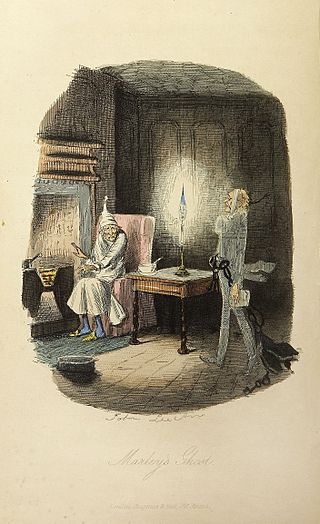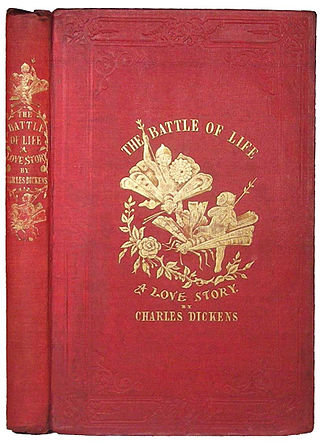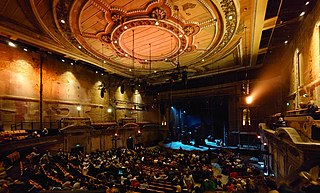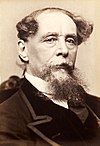
Charles John Huffam Dickens was an English novelist and social critic who created some of the world's best-known fictional characters, and is regarded by many as the greatest novelist of the Victorian era. His works enjoyed unprecedented popularity during his lifetime and, by the 20th century, critics and scholars had recognised him as a literary genius. His novels and short stories are widely read today.

A Christmas Carol. In Prose. Being a Ghost Story of Christmas, commonly known as A Christmas Carol, is a novella by Charles Dickens, first published in London by Chapman & Hall in 1843 and illustrated by John Leech. It recounts the story of Ebenezer Scrooge, an elderly miser who is visited by the ghost of his former business partner Jacob Marley and the spirits of Christmas Past, Present and Yet to Come. In the process, Scrooge is transformed into a kinder, gentler man.

Ebenezer Scrooge is a fictional character and the protagonist of Charles Dickens's 1843 short novel, A Christmas Carol. At the beginning of the novella, Scrooge is a cold-hearted miser who despises Christmas. The tale of his redemption by three spirits has become a defining tale of the Christmas holiday in the English-speaking world.

Christmas pudding is sweet, dried-fruit pudding traditionally served as part of Christmas dinner in Britain and other countries to which the tradition has been exported. It has its origins in medieval England, with early recipes making use of dried fruit, suet, breadcrumbs, flour, eggs and spice, along with liquid such as milk or fortified wine. Later, recipes became more elaborate. In 1845, cookery writer Eliza Acton wrote the first recipe for a dish actually called "Christmas pudding".

The Chimes: A Goblin Story of Some Bells that Rang an Old Year Out and a New Year In, commonly referred to as The Chimes, is a novella by Charles Dickens, first published in 1844, one year after A Christmas Carol. It is the second in his series of "Christmas books", five novellas with strong social and moral messages that he published during the 1840s. In addition to A Christmas Carol and The Chimes, the Christmas books include The Cricket on the Hearth (1845), The Battle of Life (1846), and The Haunted Man and the Ghost's Bargain (1848).

A Christmas Carol is a 1938 American drama film adaptation of Charles Dickens's 1843 novella of the same name, starring Reginald Owen as Ebenezer Scrooge, an elderly miser who learns the error of his ways on Christmas Eve after visitations by three spirits. The film was directed by Edwin L. Marin from a script by Hugo Butler.

Jacob Marley is a fictional character in Charles Dickens's 1843 novella A Christmas Carol. He is a former business partner of the miser Ebenezer Scrooge, the novella's protagonist. Marley has been dead for seven years. On Christmas Eve, Scrooge is visited at home by Marley's ghost, who wanders the Earth entwined by heavy chains and money boxes forged during a lifetime of greed and selfishness. Marley tells Scrooge that he has a single chance of redemption to avoid the same fate: he will be visited by three spirits, in the hope that he will mend his ways; otherwise, he will be cursed to carry much heavier chains of his own.

Christmas Carol: The Movie is a 2001 British live action/animated film based on Charles Dickens's 1843 novella A Christmas Carol. Directed by Jimmy T. Murakami, the film features the voices of numerous actors including Simon Callow, Kate Winslet, Kate's sister Beth Winslet, and Nicolas Cage. The film was a critical and commercial failure upon release.

The Battle of Life: A Love Story is an 1846 novella by Charles Dickens. It is the fourth of his five "Christmas Books", coming after The Cricket on the Hearth and followed by The Haunted Man and the Ghost's Bargain.

A Christmas Carol: The Musical is a 2004 American musical television film based on the 1994 stage musical by Alan Menken and Lynn Ahrens inspired by the 1843 novella of the same name by Charles Dickens.

The Ghost of Christmas Present is a fictional character in Charles Dickens' 1843 novella A Christmas Carol. The Ghost is one of three spirits that appear to miser Ebenezer Scrooge to offer him a chance of redemption.

A Christmas Carol, the 1843 novella by Charles Dickens (1812–1870), is one of the English author's best-known works. It is the story of Ebenezer Scrooge, a greedy miser who hates Christmas, but is transformed into a caring, kindly person through the visitations of four ghosts. The classic work has been dramatised and adapted countless times for virtually every medium and performance genre, and new versions appear regularly.

Crickets are orthopteran insects which are related to bush crickets, and, more distantly, to grasshoppers. In older literature, such as Imms, "crickets" were placed at the family level, but contemporary authorities including Otte now place them in the superfamily Grylloidea. The word has been used in combination to describe more distantly related taxa in the suborder Ensifera, such as king crickets and mole crickets.

Edward Richard Wright was an English comedian and actor.

The Cricket on the Hearth is a 1909 silent short film directed by D. W. Griffith. It is based on the 1845 novella of the same title by Charles Dickens.

The Cricket on the Hearth is a 1923 American silent comedy film directed by Lorimer Johnston and starring Josef Swickard, Fritzi Ridgeway, and Paul Gerson.

The Man Who Invented Christmas is a 2017 Christmas biographical comedy-drama film about Charles Dickens directed by Bharat Nalluri and written by Susan Coyne. Based on Les Standiford's 2008 non-fiction book of the same name, the joint Canadian and Irish production stars Dan Stevens, Christopher Plummer, and Jonathan Pryce, and follows Dickens (Stevens) as he conceives and writes his 1843 novella A Christmas Carol.

A Christmas Carol is a 2019 British dark fantasy drama miniseries based on the 1843 novella by Charles Dickens. The three-part series is written by Steven Knight with Tom Hardy and Ridley Scott among the executive producers. It began airing on BBC One in the U.K. on 22 December 2019 and concluded two days later on 24 December 2019. Prior to this, it aired in the U.S. on FX on 19 December 2019, with all three episodes shown consecutively as a single television film.


















